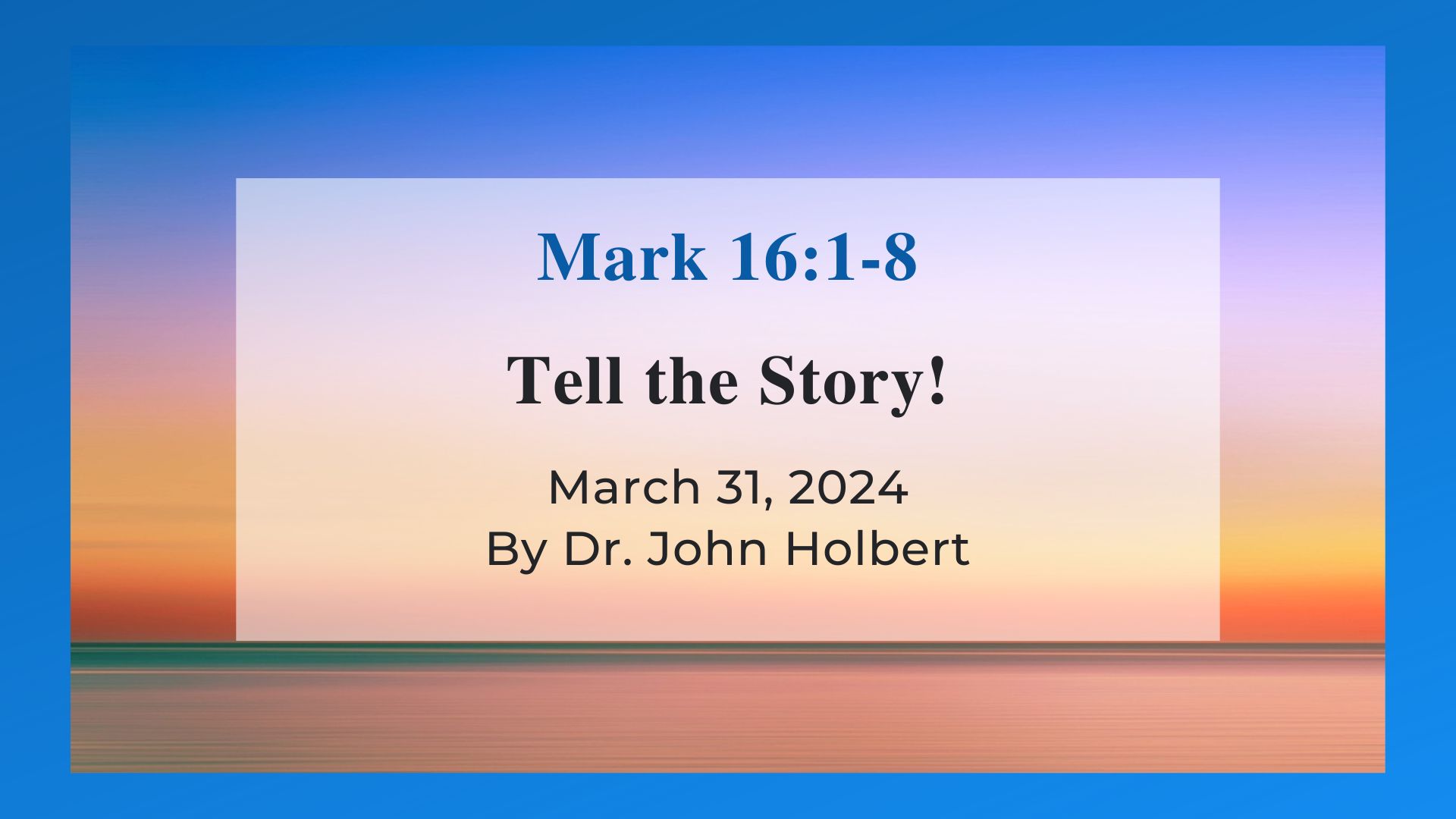Tell the Story! - Reflections on Mark 16:1-8
by Dr. John Holbert on Tuesday, March 26, 2024

Tell the Story!
Mark 16:1-8
The Peripatetic Hebrew Bible Preacher
Yes, I know that I am contracted to write articles that are based on the lectionary readings from the Hebrew Bible, but on Easter Sunday, I beg your indulgence as I recount the fabulous tale from the Gospel of Mark. As a long-time teacher in two different schools of higher education, and as a frequent guest preacher in many and various pulpits, I only one time (!) was able to preach a sermon on Easter Sunday. Even when I was an associate pastor at a large church in Louisiana about 50 years ago, Easter Sunday was always reserved for the Senior person. However, in the second of my interim pastorates, this time in Dallas First UMC, one of my Sundays there fell on Easter. So, I got to preach for the usual full house, with trumpets, drums, and a 100-voice choir as a wonderful backup to my sermon.
I remember it as if it were yesterday, though it was some 27 years ago. I chose this amazing text from Mark because I know of no better account of the astonishing event that Easter commemorates. You may, I imagine, disagree! After all, Matthew has fainting soldiers and rising corpses. Luke offers the story of two disciples trudging toward Emmaus, disconsolate until they meet the risen Jesus and recognize him when they break bread. John tells us the touching tale of Mary and her confusion about Jesus as a gardener. And Mark? Here we get the empty tomb, a man in white, and at the end silent and terrified women. Just what sort of narrative is that for an Easter Sunday?
I am glad you asked. At least three things are clear about Mark’s gospel: it is decidedly different and much shorter than its cousin synoptics, Matthew and Luke; it has nothing resembling a birth story for Jesus; and it ends in silence, a most peculiar way to conclude the story that is celebrated in our churches in the very loudest ways possible, usually including Handel’s redoubtable “Hallelujah Chorus.” Hence, the question just must be asked: what is Mark up to?
Again, I am glad you asked. What we may assume is that Mark’s gospel was first heard as a whole. That is, when it first found its way into some of the earliest Christian communities, it was read aloud to the assembled followers of the new religion, many of whom were doubtless effectively illiterate. A visiting believer would come among them and would read the 16 chapters of this new form of literature, and we may further assume that after that reading, a task of some 60-70 minutes, much discussion would ensue. What can we make of that? What does it say to us? What must we now do if we are to become followers of this crucified and risen Messiah, Jesus?
I suggest that you, as a preacher, do likewise. Of course, you hardly have the time to read the whole thing, but you can readily and handily summarize the whole into 15-20 minutes if you can grasp Mark’s central intent. Mark has one clear goal for his gospel, namely to answer the related questions of Jesus’s identity and what difference it makes for us. Here are some clues to the brilliant writer’s clever and ironic methods to answer those questions.
1. Jesus is a profound mystery from beginning to end. Each time that one follower or another gets close to revealing his identity, he strictly demands that they stay silent about it.
2. When Peter blurts out, “You are the Christ!” Jesus tells him to be quiet because he knows all too well that Peter has not a clue about what he understands by that title.
3. Only one group of gospel characters are clear about just who Jesus is: the demons! They know full well who they are dealing with and they obey his demands of them immediately. The disciples are clueless throughout the story, acting as if they simply cannot grasp what this man wants of them.
4. Finally, at the very end, after the male disciples have fled in terror, and after the faithful women have gone to the tomb as witnesses to the resurrection, and are commanded by the mysterious white-robed man to “tell the disciples and Peter” that Jesus is alive and is waiting for them in Galilee, those women “went out and fled from the tomb, for astonishing terror had seized them, and they said nothing to anyone because they were panic-stricken!” At long last, some disciples are urged, commanded, to tell somebody about who Jesus really is, and the women are struck mute!
5. Well, if no one in the tale tells about Jesus, then who needs to do so? The answer is to be found in the pulpit and pews of the church! And that is the genius of Mark: if the characters around Jesus fail to speak of him, then it is up to us to blab it all over the countryside. How else will the world know that God has raised Jesus and that his message of love and justice persists even now in a world in desperate need of both?
Though scholarship through the centuries has paid comparatively little attention to Mark in favor of the other three gospels, for me Mark got the tale right and offered it up to us with irony, joy, and genuine delight. Why not give your congregation the opportunity to hear, really hear, the story once again?
